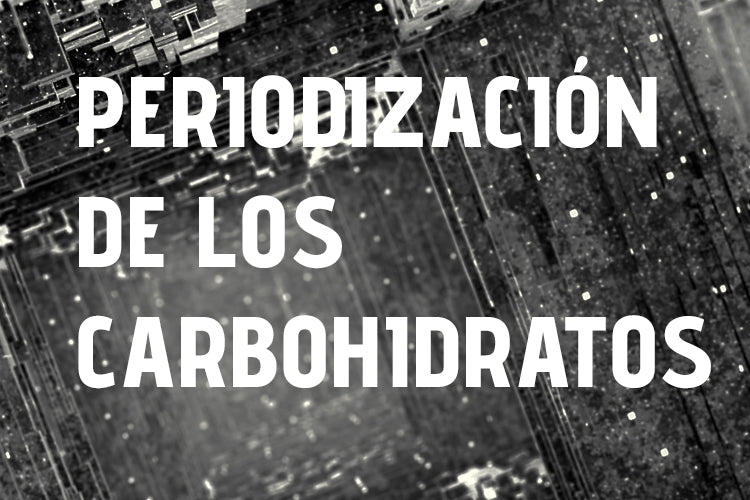Carbohydrate periodization has been gaining popularity in recent years as it improves athletic performance . Therefore, in this guide, we'll explain what carbohydrate periodization is and how to implement it safely to improve your athletic or competitive performance.
The first thing we should know is that there is a close relationship between carbohydrate (CH) metabolism and sports performance . Thus, we become tired or fatigued when our glycogen stores begin to run low. Therefore, when exercising, such as during a race, it is advisable to consume CH.
Carbohydrate periodization involves strategically reducing carbohydrate consumption during workouts, especially when these are at a gentle intensity. This, combined with a high carbohydrate intake during a specific high-intensity workout or competition, allows our performance to dramatically improve and adapt.
Thus, carbohydrate periodization is based on a simple but powerful concept: not all days are created equal in terms of energy requirements . For example, on intense training days, such as high-intensity sessions, your body needs an adequate supply of carbohydrates to boost performance and recovery. In contrast, on rest days or days of light physical activity, carbohydrate intake can be reduced to promote fat burning. This is the key to the success of carbohydrate periodization.
How does glycogen act in our body?
Muscle glycogen can mediate cellular signaling pathways associated with adaptation to resistance training (1), inducing an increased muscle transcriptional response when exercise is completed under conditions of reduced muscle glycogen availability (5, 6).
In fact, compared to loaded glycogen stores, training with reduced muscle glycogen has been shown to increase AMP-activated protein kinase (AMPK) activity as a result of decreased AMPK-glycogen binding (7, 8).
Thus, AMPK acts as a cellular energy sensor, upregulating the activity and expression of peroxisome proliferator-activated receptor 1 coactivator alpha (PGC-1α) (9 , 10 , 11) , a transcriptional coactivator often touted as the master regulator of mitochondrial biogenesis (12 , 13), a key hallmark of adaptation to resistance training (14 , 15) .
Concomitant with these adaptations, increased mobilization of body fat for energy supply during exercise with low glycogen availability upregulates the peroxisome proliferator-activated receptor (PPARδ) transcription factor (16) , thereby increasing the expression of proteins involved in lipid metabolism. Such metabolic adaptation may be beneficial for improving performance during prolonged submaximal steady-state exercise by sparing glycogen stores for later utilization (17 , 18) .
Consequently, over the past decade, several dietary carbohydrate (CHO) exercise periodization strategies (i.e., twice-daily training, fasted training, withholding CHO intake between exercise sessions) to train with low muscle glycogen (coined as “low training”), have been tested in athletes (19 , 20 , 21 , 22).
What is periodized nutrition?
It is important to define the terms 'periodized nutrition' and 'nutritional training'. The words 'training' and 'periodized', by definition, refer to a structured and planned process. In reality, there is often little planning when it comes to nutrition and limited integration of training and nutritional practices. What athletes consume after exercise may depend on the training, but careful planning before training, with long-term goals in mind, is still relatively uncommon. (1)
"Nutrition should be periodized and adapted to support changing individual goals, training levels, and requirements throughout a season and/or training cycle."
For example, the guide How to Train Your Gut would be included in this definition of periodized nutrition.
The terms periodized nutrition and nutritional training can be used interchangeably, and the selection of nutritional training methods is very goal-specific (2) . For example, if the goal is to specifically develop fat metabolism, sleep-low-train-low training may play a role in achieving these specific adaptations. However, to achieve gastrointestinal (GI) absorptive capacity adaptations to carbohydrates, a higher carbohydrate intake would be recommended.
There are several models like these (1) :

First we want to clarify the issue of the famous ketogenic diet, as a strategy when we want to be lipoefficient (efficient with fat burning), in this guide we clarify it for you
What is sleep low train low?
Sleep Low-Train Low is a training and nutrition strategy intended to deliberately reduce muscle glycogen availability during specific exercise sessions, potentially amplifying the training stimulus through increased cellular signaling.
It includes three different training and nutrition interventions: high-intensity training (HIT) in the evening to deplete glycogen stores, followed by low CHO availability overnight (i.e., sleeping on low carbohydrates) and low-intensity training (LIT) the following morning under conditions of low muscle glycogen/CHO availability.
If you want to have an example and do it, we have developed a pdf with 1 training protocol (6 × 5 min of cycling at 105% of FTP interspersed with 5- min recovery at 55% FTP. It has been shown that eight series of 5 min at high intensity with 60 s of recovery (23) are effective in significantly reducing muscle glycogen content (~50%) and have been previously used in a “sleep low, train low” intervention (24) ) and nutrition with which you can do it for 3 weeks, which is where this type of strategy has been seen to benefit, click here to download it.
The “sleep low, train low” model appears particularly suited to athletic populations because exercise timing and CHO restriction minimize waking hours and maximize duration under low CHO conditions, potentially maximizing the adaptive response (3) .
Benefits of Carbohydrate Periodization
Regarding performance outcomes, improvements of 4.0%, 2.3%, and 5.5% were observed in 20 min, 5 min, and FTP (W kg -1 ), respectively. Using a similar exercise and nutrition intervention, Marquet et al. (3) reported an improvement in 10 km race time (-2.9%) and an increase in time to exhaustion in supramaximal cycling (150% of maximal aerobic power) (+12.5%) in triathletes, showing improvements during both aerobic and anaerobic exercise.
Understanding the daily impact of training with reduced CHO availability is important for coaches, sports scientists, and nutritionists.
In this study, we can observe what was mentioned above.


The sleep-low-train-low method is just one of the many strategies available for nutritional periodization. This one, in particular, is supported by scientific evidence that supports its use during periods of the season when we want to place greater emphasis on fat oxidation.
Despite reductions in relative training intensity over three weeks, we provide data demonstrating that three weeks of “sleep low, train low” is effective in improving functional threshold power (FTP) and 5-minute PPO in trained cyclists and triathletes, with no benefit for high-intensity exercise performance (1-minute PPO) compared to “normal” carbohydrate availability (4).
Literature
- Jeukendrup A. Training the gut. Sports Med. 2016.
- Hawley JA, Burke LM. Carbohydrate availability and training adaptation: effects on cell metabolism. Exerc Sport Sci Rev 2010;38:152–60.
- Marquet LA, Brisswalter J, Louis J, et al. Improved endurance performance by periodization of carbohydrate intake: “sleep low” strategy. Med Sci Sports Exerc. 2016;48:663–72.
- Samuel Bennett, Eve Tiollier, Franck Brocherie, Daniel J. Owens, James P. Morton, Julien Louis. Three weeks of a home-based “sleep low-train low” intervention improves functional threshold power in trained cyclists: A feasibility study. December 2, 2021
- Pilegaard H, Keller C, Steensberg A, Helge JW, Pedersen BK, Saltin B, et al. Influence of pre-exercise muscle glycogen content on exercise-induced transcriptional regulation of metabolic genes. J Physiol. 2002;541(Pt 1):261–71. pmid:12015434
- Stocks B, Dent JR, Ogden HB, Zemp M, Philp A. Postexercise skeletal muscle signaling responses to moderate-to high-intensity steady-state exercise in the fed or fasted state. Am J Physiol Endocrinol Metab. 2019;316(2):E230–E8. pmid:30512989
- McBride A, Ghilagaber S, Nikolaev A, Hardie DG. The glycogen-binding domain on the AMPK beta subunit allows the kinase to act as a glycogen sensor. Cell Metab. 2009;9(1):23–34. pmid:19117544
- Polekhina G, Gupta A, van Denderen BJ, Feil SC, Kemp BE, Stapleton D, et al. Structural basis for glycogen recognition by AMP-activated protein kinase. Structure. 2005;13(10):1453–62. pmid:16216577
- Philp A, Hargreaves M, Baar K. More than a store: regulatory roles for glycogen in skeletal muscle adaptation to exercise. Am J Physiol Endocrinol Metab. 2012;302(11):E1343–51. pmid:22395109
- Canto C, Auwerx J. PGC-1alpha, SIRT1 and AMPK, an energy sensing network that controls energy expenditure. Curr Opinion Lipidol. 2009;20(2):98–105. pmid:19276888
- Philp A, Chen A, Lan D, Meyer GA, Murphy AN, Knapp AE, et al. Sirtuin 1 (SIRT1) deacetylase activity is not required for mitochondrial biogenesis or peroxisome proliferator-activated receptor-gamma coactivator-1alpha (PGC-1alpha) deacetylation following endurance exercise. J Biol Chem 2011;286(35):30561–70. pmid:21757760
- Lin J, Handschin C, Spiegelman BM. Metabolic control through the PGC-1 family of transcription coactivators. Cell Metab. 2005;1(6):361–70. pmid:16054085
- Wu Z, Puigserver P, Andersson U, Zhang C, Adelmant G, Mootha V, et al. Mechanisms controlling mitochondrial biogenesis and respiration through the thermogenic coactivator PGC-1. Cell. 1999;98(1):115–24. pmid:10412986
- Holloszy JO. Biochemical adaptations in muscle. Effects of exercise on mitochondrial oxygen uptake and respiratory enzyme activity in skeletal muscle. J Biol Chem. 1967;242(9):2278–82. pmid:4290225
- Holloszy JO, Oscai LB, Don IJ, Mole PA. Mitochondrial citric acid cycle and related enzymes: adaptive response to exercise. Biochem Biophys Res Commun. 1970;40(6):1368–73. pmid:4327015
- Pilegaard H, Osada T, Andersen LT, Helge JW, Saltin B, Neufer PD. Substrate availability and transcriptional regulation of metabolic genes in human skeletal muscle during recovery from exercise. Metabolism. 2005;54(8):1048–55. pmid:16092055
- Hearris MA, Hammond KM, Fell JM, Morton JP. Regulation of Muscle Glycogen Metabolism During Exercise: Implications for Endurance Performance and Training Adaptations. Nutrients. 2018;10(3). pmid:29498691
- Stellingwerff T, Boon H, Gijsen AP, Stegen JH, Kuipers H, van Loon LJ. Carbohydrate supplementation during prolonged cycling exercise spares muscle glycogen but does not affect intramyocellular lipid use. Pflugers Arch. 2007;454(4):635–47. pmid:17333244
- Psilander N, Frank P, Flockhart M, Sahlin K. Exercise with low glycogen increases PGC-1alpha gene expression in human skeletal muscle. Eur J Appl Physiol. 2013;113(4):951–63. pmid:23053125
- Lane SC, Camera DM, Lassiter DG, Areta JL, Bird SR, Yeo WK, et al. Effects of sleeping with reduced carbohydrate availability on acute training responses. J Appl Physiol (1985). 2015;119(6):643–55. pmid:26112242
- Yeo WK, Paton CD, Garnham AP, Burke LM, Carey AL, Hawley JA. Skeletal muscle adaptation and performance responses to once a day versus twice every second day endurance training regimens. J Appl Physiol (1985). 2008;105(5):1462–70.
- Gejl KD, Thams LB, Hansen M, Rokkedal-Lausch T, Plomgaard P, Nybo L, et al. No Superior Adaptations to Carbohydrate Periodization in Elite Endurance Athletes. Med Sci Sports Exerc. 2017;49(12):2486–97. pmid:28723843
- Stepto NK, Martin DT, Fallon KE, Hawley JA. Metabolic demands of intense aerobic interval training in competitive cyclists. Med Sci Sports Exerc. 2001;33(2):303–10. pmid:11224822
- Marquet LA, Brisswalter J, Louis J, Tiollier E, Burke LM, Hawley JA, et al. Enhanced Endurance Performance by Periodization of Carbohydrate Intake: “Sleep Low” Strategy. Med Sci Sports Exerc. 2016;48(4):663–72. pmid:26741119




Leave a comment
This site is protected by hCaptcha and the hCaptcha Privacy Policy and Terms of Service apply.